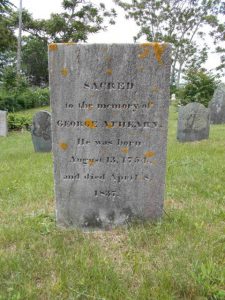 I want to love the husband of my favorite ancestor, Hepsibah, as much as I love her … but I can’t. When I first began researching George Athearn,[1] he seemed to be the very model of an eighteenth-century gentleman: a 1775 graduate of Harvard and judge of probate in his hometown. I was proud to have him as an ancestor, ecstatic to stay five nights in his former home, and diligent in finding out everything I could about him. Continue reading Hard to love
I want to love the husband of my favorite ancestor, Hepsibah, as much as I love her … but I can’t. When I first began researching George Athearn,[1] he seemed to be the very model of an eighteenth-century gentleman: a 1775 graduate of Harvard and judge of probate in his hometown. I was proud to have him as an ancestor, ecstatic to stay five nights in his former home, and diligent in finding out everything I could about him. Continue reading Hard to love
A case of Civil War PTSD
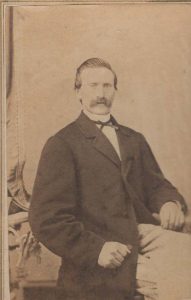
Although the term PTSD (Post-Traumatic Stress Disorder) did not come into widespread use until a century after the Civil War, the aberrant and antisocial behavior of Irving Brewster Delano (1840–1905) of Fairhaven, Massachusetts, seems to fit some of its symptoms. He served in the United States Navy from October 1862 until October 1863 aboard the U.S.S. North Carolina, Dacotah, and Alleghany. Irving’s family entry in the prodigious genealogy, The American House of Delano, gives details on his marriage and the births of his three children but neglects to mention his divorce.
From the evidence of the Delano family gravestone in Riverside Cemetery in Fairhaven, with full dates for birth and death, Irving would seem to be tucked in the family plot among his parents and three of his siblings. In fact, though, he died far from home in Haskell, Polk County, Florida, where he had lived as a lone Yankee for the last twenty years of his life. Continue reading A case of Civil War PTSD
Genealogical lessons

Many genealogists will tell you that they get absorbed into the world of the ancestors they are researching. Often one can’t help but recreate their environment and the things they experienced while seeking out documents that help piece together that puzzle. Due to the nature of my work, for me this means coming face to face with the realities of slavery and colonization nearly every day.
Slavery research can be difficult logistically as I try to piece together the lives of ancestors where little documentation exists. The harder aspect of the work is emotional, particularly when it means going page by page through slavery registers of children to find an ancestor recorded among them. Regardless of the challenges, it is important work that has provided me with a much deeper understanding of our past as a nation and the continuing implications of that history on our present. Continue reading Genealogical lessons
Citations
 First, does the book give footnotes, endnotes, or other citations to the sources the author used? Second, are those citations useful?
First, does the book give footnotes, endnotes, or other citations to the sources the author used? Second, are those citations useful?
One could say that “any citation is better than none,” and citations do not have to follow all of the “manual of style” rules to be useful. Their main purpose is to tell the reader where the information came from. That said, an understanding of standardized citation rules is always better than none. Continue reading Citations
‘No sin in being tempted’
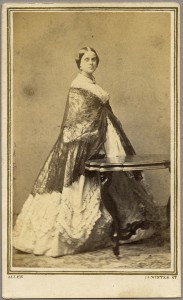
61 Bowdoin Street, Boston, Wednesday, 10 May 1865: Poor Lottie Hemingway [sic] was buried at noon yesterday. [It] was a pouring rain, and I suppose no one dared to go to the house – the disease is so fearfully malignant. If sympathy could comfort, her poor mother might be consoled, for all our hearts ache for her. And she must be so anxious for the other children. It seems Lottie did not sicken till Wednesday and [her sister] Amy[2] slept with her as usual till that time – spotted fever with violent spinal inflammation.
Our precious daughter[3] comes home tomorrow from her week’s visit to Annie Dixwell.[4] We shall be glad to get her back – she leaves an awful blank in her absence. Continue reading ‘No sin in being tempted’
Filles du Roi
 With the genealogy that I’ve completed so far on my family, I have found that I am French – so French! I have one great-grandparent from Roscommon, Ireland, but the rest of my family, as far back as I can research, is French. My maternal family originated in Meaux, France, while my paternal family came from Paris. Both sides emigrated to Quebec, Canada in the mid-1600s among the early settlers of New France.
With the genealogy that I’ve completed so far on my family, I have found that I am French – so French! I have one great-grandparent from Roscommon, Ireland, but the rest of my family, as far back as I can research, is French. My maternal family originated in Meaux, France, while my paternal family came from Paris. Both sides emigrated to Quebec, Canada in the mid-1600s among the early settlers of New France.
As someone who has researched the history of the Mayflower passengers for her job, I am familiar with the excitement and honor of being related to an early settler. According to the American-French Genealogical Society website, most people who can trace their ancestry to Canada are descended from one of the 800 women who settled there as part of a program that began in 1663. This program was called “les Filles du Roi,” or “the King’s Daughters.” Continue reading Filles du Roi
What’s her name?
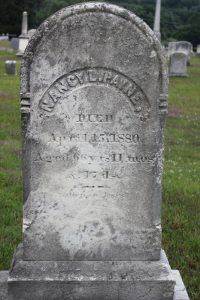
While today a married woman going back to an earlier surname is not that uncommon, such a progression sometimes happened in earlier time periods. The following case was interesting, as this individual appeared to be going “back and forth” between the surnames of her two spouses – her reasoning is hard to follow.
Nancy Lippitt was born at Killingly, Connecticut 17 November 1813, the daughter of Nathaniel and Rebecca (Bartlett) Lippitt. She married Comstock Paine of Smithfield, Rhode Island, at Killingly 17 January 1833; they had one son, Charles L. Paine (1840–1879). I can’t find the family in the 1840 census, but some of the pages for Killingly are now illegible. Nancy L. Paine appears without her husband in the 1850 census in Thompson, Connecticut (which then bordered Killingly), along with her son Charles. Continue reading What’s her name?
‘May sunshine ever stream’
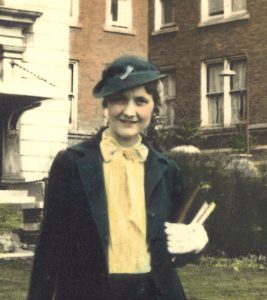
Among the family photos, letters, and other memorabilia that my mother passed on to me are a group of Valentine’s Day cards sent to my great-aunt, Anna E. Johnson (1896–1990), who received them from her classmates at Hopewell School in Scott County, Iowa, in the early 1900s. When she sent them to my mother she said that she was sending these among others in her collection because “I thought these were the lacy ones.” Indeed, my mother and I found them so special that they remain family treasures today. Continue reading ‘May sunshine ever stream’
‘Neutral ground’

Many of us have bunches of old family letters set aside to review – preferably with the sender and the recipient already noted on the envelope. Years ago, as I was researching my first family history (The Sarsaparilla Kings[1]), I was fortunate enough to have some published (as well as unpublished) sources available to consider the relationship between my great-great-grandfather Frederick Ayer (1822–1918) – one of the two Sarsaparilla Kings – and his son-in-law George Smith Patton Jr. (1885–1945).
Frederick Ayer made two distinct fortunes – in patent medicines with his elder brother, Dr. J. C. Ayer, and in textiles and other investments later in life – and by the turn of the twentieth century he was a wealthy man. His second wife, Ellen Barrows Banning (1853–1918), was a member of a sprawling family with connections in Delaware, Minnesota, and California, among them to the family of George and Ruth Patton of San Gabriel, California. Continue reading ‘Neutral ground’
Royal cartes de visite: Part Four
[This series on royal cartes de visite began here.]
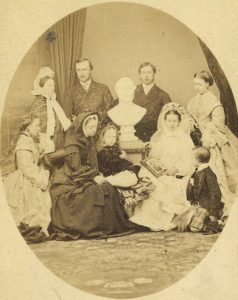 At left: The wedding of the Prince of Wales and Princess Alexandra of Denmark, 1863. Standing: The Crown Princess of Prussia, Prince Louis of Hesse, the bridegroom, and Princess Helena. Seated or kneeling: Princess Louise, the Queen, Princess Beatrice, the bride (holding a photo of the late Prince Consort), and Prince Arthur.[1]
At left: The wedding of the Prince of Wales and Princess Alexandra of Denmark, 1863. Standing: The Crown Princess of Prussia, Prince Louis of Hesse, the bridegroom, and Princess Helena. Seated or kneeling: Princess Louise, the Queen, Princess Beatrice, the bride (holding a photo of the late Prince Consort), and Prince Arthur.[1]
The daughters-in-law of Queen Victoria and the Prince Consort entered a household in mourning; what Princess Alexandra found in 1863 Grand Duchess Marie encountered in 1874, and as late as 1882 the young Duchess of Albany knew it, too, although time had somewhat muffled the early excesses of the Queen’s grief. Continue reading Royal cartes de visite: Part Four